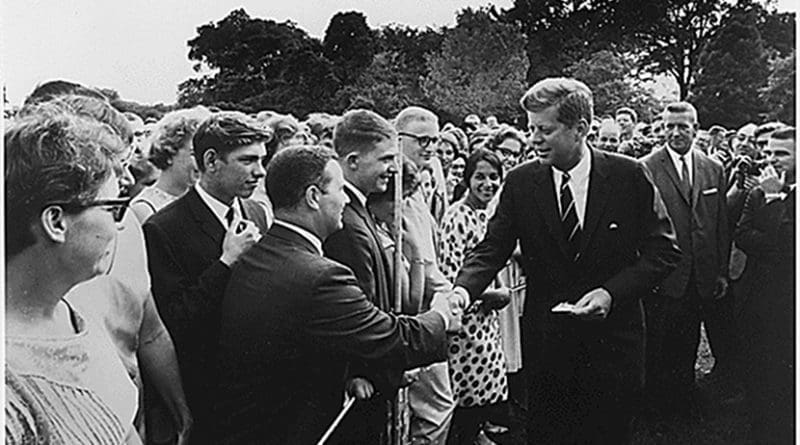The Myth That America Prospered After WWII Despite Extremely High Taxes On The Rich – OpEd
By FEE
By Dr Rainer Zitelmann*
Left-wing politicians who demand higher taxes on the rich argue that the United States has, in the past, prospered when tax rates were very high, proving that high taxes do not harm the economy. And it is true: In the 1950s and early 1960s, the top federal personal income tax rate in the US was a horrendous 91 percent, after which it was lowered to 70 percent. Under Ronald Reagan, it was then successively reduced to 28 percent by 1988 (before being raised several times and then lowered again under Trump).
However, as Phil Gramm, Robert Ekelund, and John Early show in their book The Myth of American Inequality: “The top income tax in 1962 was 91 percent. After deductions and credits, only 447 tax filers out of 71 million paid any taxes at the top rate. The top 1 percent of income earners on average paid 16.1 percent of their income in federal and payroll taxes while the top 10 percent paid 14.4 percent and the bottom 50 percent paid 7.0 percent.”
Even when the top tax rate was lowered to 70 percent, not much changed. Only 3,626 out of 75 million taxpayers actually paid taxes up to 70 percent. Interestingly, the actual percentage paid by the top 1 percent of earners in the US was only 16.1 percent in 1962, when the top marginal rate was 91 percent. However, in 1988, when the top rate was only 28 percent, the percentage paid by the top 1 percent of earners had risen to 21.5 percent! As the top tax rate fell by two-thirds, the percentage of their income that the top 1 percent of tax filers paid in federal income and payroll taxes rose by a third.
This seems paradoxical, but it is logical, because it is not only the tax rate that is decisive, but the amount of income that is actually taxable. In the pre-Reagan era, there were numerous exemptions, loopholes, and tax-saving schemes that top earners could use to reduce their taxable income. Reagan abolished many of these opportunities, thereby increasing the proportion of income that was subject to taxation.
The Reagan-era tax cuts likely contributed to the higher economic growth rates experienced in the 1980s. During the Reagan years, economic growth averaged 3.2 percent per year, compared to 2.8 percent during the Carter–Ford years and 2.1 percent during the Bush–Clinton years. The growth rate for the Reagan years includes the recession of the early 1980s, a side effect of reversing inflation that had spiked during the Carter years. From 1983 to 1989, GDP grew by 3.8 percent a year, and by the end of Reagan’s second term, the US economy was almost one-third larger than when he first took office. This growth was a direct consequence of Reagan’s deregulation and tax reform policies in conjunction with falling oil prices. The growth rate in the 1980s was higher than in the 1950s and 1970s, though substantially below the growth rate of 5 percent following John F. Kennedy’s 1964 tax rate cuts of 30 percent.
This growth, along with the elimination of numerous deductions and exemptions, led to a sharp increase in tax revenues. This, it should be noted, is precisely what Reagan had predicted.
At a press conference in October 1981, Reagan quoted the 14th-century Muslim philosopher Ibn Khaldūn’s foreshadowing of the Laffer Curve theory, as this effect is called in economic jargon: “In the beginning of the dynasty, great tax revenues were gained from small assessments. At the end of the dynasty, small tax revenues were gained from large assessments.” Reagan added: “And we’re trying to get down to the small assessments and the great revenues.”
So the myth that the US experienced strong economic growth when the top marginal tax rate was high is false. In fact, the top marginal tax rate was only nominally high because there were so many exemptions, loopholes, and deductions.
*About the author: Rainer Zitelmann is a historian and sociologist and author of the new book In Defense of Capitalism.
Source: This article was published by FEE


Article not worth reading because no discussion of wealth gap. “In the 1950s and early 1960s, the top federal personal income tax rate in the US was a horrendous 91 percent, after which it was lowered to 70 percent. Under Ronald Reagan, it was then successively reduced to 28 percent by 1988 (before being raised several times and then lowered again under Trump).” — but after loopholes only 16 percent?
Ok even if true consider the possibility that the wealthy stopped hoarding and instead started distribution of wealth to get tax breaks. That gave opportunity to others to become wealthy. The economy booms owing to opportunities.
Bottom line – do not flip or distribute. Let’s see this kind of article only when the wealth gap is included.
Seems to be an argument for hiring more IRS agents.